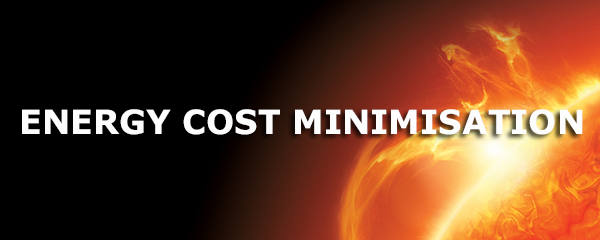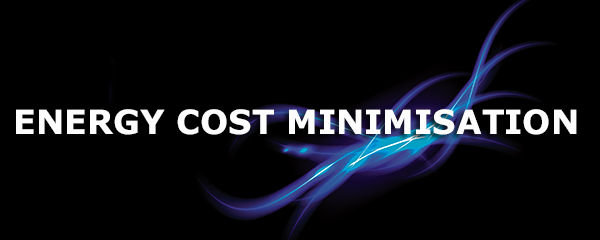Energy prices have risen rapidly over recent years and will continue to do so for many years to come. The best defence against rising energy prices that ensures your business’ ongoing prosperity and competitiveness will be your ability to use energy as efficiently as possible.
Electricity is the main energy source for most businesses and the bottom-line benefits of maximising energy efficiency and minimising energy costs are increasingly the focus of senior management. But you can’t manage what you don’t measure, so the first step in developing a successful Energy Cost Minimization Strategy is to have a comprehensive energy audit. Use this link to learn more: Professional Energy Assessment.
There is no single measure by which you can achieve energy efficiency – no ‘silver bullet’ solution – but rather a suite of measures, each of which helps increase energy efficiency and reduce energy costs, and which, when tailored to your particular business, collectively constitute your Energy Cost Minimization Strategy.
While some measures might be specific to a particular site, geographic location or business sector, the following have almost universal application:
- Behavioural / Cultural Changes: During the period of low energy prices, we developed wasteful energy habits –e.g. lights left on unnecessarily, air-conditioning turned up too high (in winter) or too low (in summer), machines and appliances not switched off at night etc. Employees are usually more than willing to make the behavioural changes necessary to rectify this, if given appropriate advice and information. The energy cost savings can be significant – 10-20% is achievable – and, best of all, it costs next to nothing.
- Energy Efficiency Upgrades: Rapidly rising energy costs have given rise to new, energy efficient technologies, whose operating costs are substantially lower than the old technologies and methods. Often a ‘payback period’ for capital expenditure of less than 3 years is achievable. The biggest savings are usually made in the areas of greatest consumption. For most businesses, these will be:
- HVAC (Heating, Ventilation, Air-conditioning): typically accounts for 40-50% of energy consumption. New, energy efficient inverter technology, more responsive thermostat controls and Off Peak chiller technology are just some of the methods available to substantially reduce the energy costs of HVAC. Use this link to learn more: Air-Conditioning
- Lighting: Lighting for businesses is usually on all day and is rightly considered the ‘lowest of low-hanging fruit’ when it comes to energy efficient upgrades. New lighting technologies, like LEDs, can replace incandescent, fluorescent, halogen and metal halide lighting, with immediate energy cost savings of 50% or more. The new lighting is very cost effective, with payback periods of less than 2 years often possible. Use this link to learn more: Energy Efficient Lighting
- Systemic Problems: Reliance on the Grid for your electricity, means your energy costs depend, in part, on the state of the Grid in your local area. The main problems are typically:
> High Voltage:Is a site-specific problem but approximately 90% of buildings in Australia receive voltage from the Grid at a higher level than is optimum for the equipment and/or appliances you run. The result is inefficiency and wasted energy. Technology is available to optimize your voltage levels. Energy cost savings of 15% are often achieved and the longevity of your equipment is extended. Use this link to learn more: Voltage Optimization
> Power Factor (PF): Is a measure of how effectively incoming power is used in your business premises and is defined as the ratio of real (working) power to apparent (total) power. If your PF is low, less than 0.9, you may be paying more than you need to for your electricity (as well as being in breach of your network supply agreement!). Technology is available to raise your PF. Energy cost savings of 10% or more are achievable and the longevity of your equipment is extended. Use this link to learn more: Power Factor Correction.
- Energy Storage Systems: Whilst electricity prices across the board have increased rapidly over recent years, the Peak electricity tariff has increased most of all, widening the price differential between Peak and Off Peak tariff rates considerably. Storing Off Peak electricity in batteries, or other energy storage systems, and then using it during Peak tariff periods is now a viable business proposition. Whilst storing grid electricity, does not reduce the amount of electricity you use, it does reduce the cost. If storing PV Solar electricity, it does both! Use this link to learn more: Energy Storage Systems.
- Self-Generation of Electricity: There are a number of different technologies, e.g. wind, solar, fuel cell, that enable you to generate your own electricity. For most businesses, however, self-generation means PV Solar. Rapidly rising electricity tariffs and dramatically falling PV system costs, mean PV electricity is already at grid-price parity for many Australian businesses. And as these trends continue, the financial benefits of self-generation will only increase. Combined with batteries, ‘solar+storage’ systems have huge potential to minimise your energy costs. Use this link to learn more: Solar+Storage.
If you would like to discuss having an Energy Cost Minimization Strategy tailored to the needs of your particular business, contact Richard Pryke on 0435 628 138 or email: {HERE}

